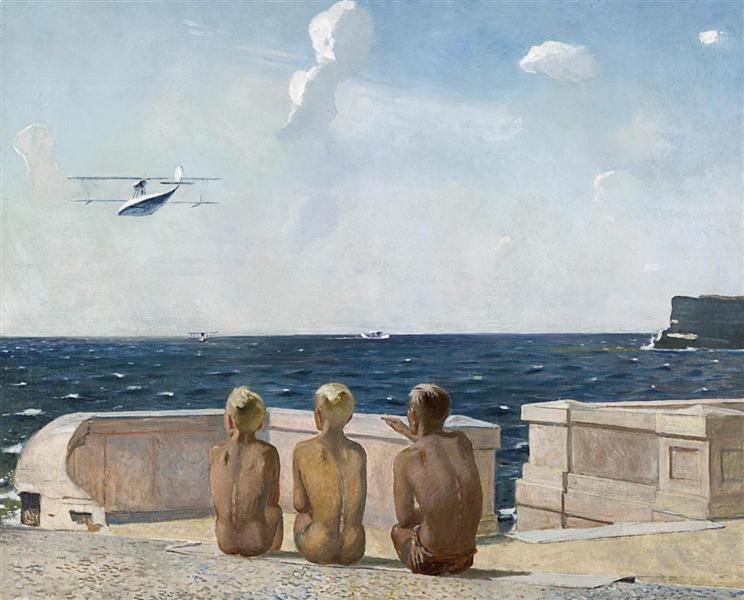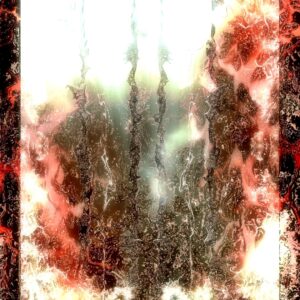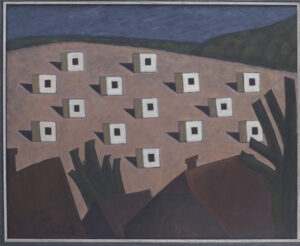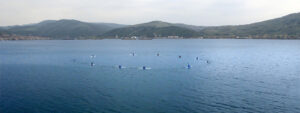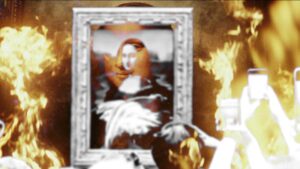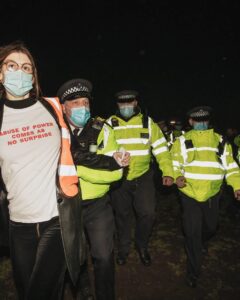In the summer of 2022, during the Ukrainian counteroffensive in Crimea, a viral video showed a Russian woman crying and complaining that she had to leave Alushta where she felt “like at her own home” (po-domashnemu) and where everything was “heartfelt” (dushevno).[1] The crying Russian woman’s affection towards Crimea echoes other Russian settler accounts of Crimea. For example, on 28 December 2022, an Instagram account named “nastya.mizgir” described the “summer breeze and the sound of the sea swash.”[2] Another account named “crimea_lovely” promotes a range of tourist routes in Crimea, from observing lavender fields to watching the dolphins.[3] These accounts reproduce the Russian perspective on occupied Crimea as a vacation destination. In the 2020 song “Crimea”, Russian rock singer Zemfira casually solidifies the settler perception: “I will unequivocally quit smoking // because smoke infuriates you // and my cough, like a sick person’s cough, infuriates you // and we would have to go to Crimea.”[4]
The Russian vacations are conditioned by the ongoing occupation of Crimea and the repressions against Crimean Tatars. Mumine Salieva, activist and a member of “Crimean Solidarity,” has described this process as a “hybrid deportation:”
Today, statistically, trouble has entered every third Crimean Tatar house. Therefore, we are describing it as the repression of an entire population. Many believe that it is nothing less than hybrid deportation. In 1944, called criminals, the Crimean Tatars were taken out of the Crimea. Today, similarly, people are put into police wagons and taken to Russian prisons by being labelled “criminals”—terrorists, extremists, separatists.[5]
Since the start of the full-scale Russian invasion of Ukraine, the repressions have worsened, including imprisonment for up to 20 years. More than 110 Crimean Tatar political prisoners are held captive by the Russian state. The forced conscriptions, which disproportionally target Crimean Tatars in Russian-occupied Crimea, have become a method of forced displacement with many Crimean Tatars fleeing Crimea to avoid conscription.[6] The dispossession of indigenous peoples is coupled with the destruction of soil and water caused by the combination of military occupation, material extraction and waste dumping.[7] Together, these processes constitute the atmospheres of settler colonial violence maintained by the Russian culture.
We will use paintings by Russian artists Konstantin Korovin and Alexander Deyneka as entry points to discuss how settler colonial occupation has been normalized by Russian visual culture. Finally, using Mamut Churlu’s painting “Return. Maryino I.” as a starting point, we will discuss land reclamation as a spatial and temporal project.
Pier in Gurzuf
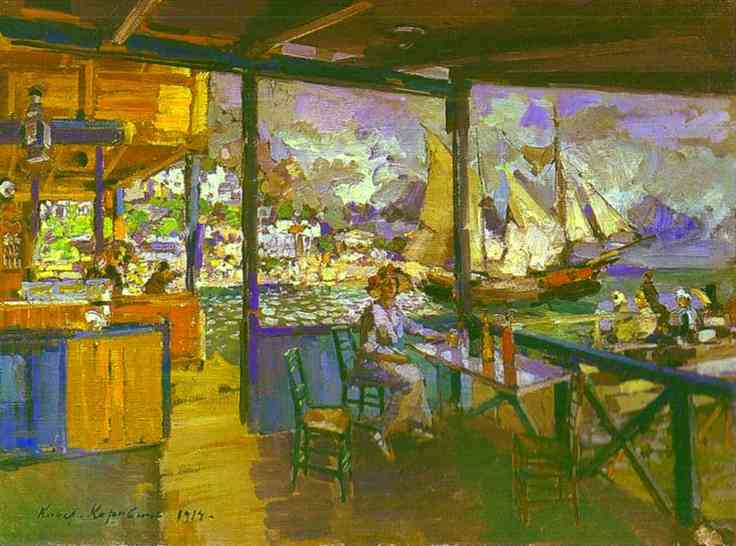 Figure 1. Pier in Gurzuf (1914) by Konstantin Korovin (oil on canvas; 89x121cm).
Figure 1. Pier in Gurzuf (1914) by Konstantin Korovin (oil on canvas; 89x121cm).
The painting (figure 1) shows an idyllic picture: a woman enjoying a drink with a couple of ships sailing in the background, flickering water, and wooden panels coloured in gold by the sunset. One can almost feel the sea breeze and the warmth of the setting sun. This impressionist painting by Russian artist Konstantin Korovin is set in Crimea, representing recurring settler colonial fantasy. It is set in Gurzuf where artist’s dacha (vacation house), built on indigenous Crimean Tatar land, was located. Yet the only people who get to enjoy the idyllic sea views are white Russians. As his memoirs show, Korovin saw Crimean Tatars solely as muzhiks (workers who did not possess land).[8] His description of a young Crimean Tatar man called Asan reveals the racialized view that maintained settler land ownership. He describes Asan with dehumanizing metaphors, solidifying Korovin’s position as a white settler observer.[9]
Korovin’s dacha was a house specifically built and owned for vacation purposes, one among many that served Russians on the peninsula. The settler ownership of dachas amounted to a “racial regime of ownership.”[10] While Russians would own their second houses in Crimea, most Crimean Tatars could not own any land and had to work for wealthy Russian settlers. This regime of ownership was conditioned by the occupation of Crimea as well as the displacement of indigenous peoples. Russian imperial authorities first formulated the legal conditions of anti-indigenous violence in 1687 in a military ultimatum against the Ottoman Empire. The demand insisted on the “dispossession of all Tatars out of Crimea.” This aim was adopted in the official “Political Conception of the Russian Empire” in 1771: “those people [Crimean Tatars] must be destroyed with our arms; their lands must be emptied as those people produce zero benefits or value.”[11]
The results of the displacement, caused by the Russian occupation of Crimea, were described in 1907 by Abdurreşit Medhi Crimean Tatar politician and the founder of the “Young Tatars” movement:
Our people include 50,000 peasants without land. The lands of the vakıf [denomination-based foundations that administered the buildings, wastelands and grazing lands that served their religious community], the state, and the proprietors of the crown remain unproductive, nourishing only a few privileged ones. In the past, all these lands belonged to the Tatar people but have now passed into the hands of others.[12]
For Russians, whose possession of dachas solidified the occupation, Crimea was rendered a “paradise peninsula.” Russian writers and poets saw Crimean landscapes as “poetic canvases of glimmering peaks and deep ravines, whose grandeur leads a romantic persona towards the implicit embrace of colonialism.”[13]
In the words of Crimean Tatar historian Gulnara Bekirova, the 19th century saw Crimea “become empty” as whole Crimean Tatar villages fled the Russian occupation.[14] After the first annexation, Prince Potemkin gave the indigenous lands to Catherine II’s ‘favourites’ so that they could build summer recreational houses.[15] The serfs brought to the peninsula by the new landowners did not know how to work this unfamiliar land. The forests were felled for military vessels. The wellsprings, which had been watering the steppe, were dried. The fertile soil, unbound by the roots of plants either cut or dried out, was dispersed. This first phase of colonial settlement not only triggered the collapse of the local ecology but also enforced further displacement. The peasants brought to cultivate Crimean land themselves eventually deserted the region. Meanwhile, Crimean Tatars became tenants only to abandon them several years later due to the threat of famine created by the settlers. Empress Catherine II expanded the peninsula’s colonization by adding knowledge production to settlement politics. She sent the natural scientist, Carl Gablitz, to catalogue all the flora in Crimea. As a result, indigenous knowledge was erased and replaced with that of the colonizers.[16] It was not only the knowledge that was replaced. In an attempt to construct a “Garden of Eden,” new plants were brought to the peninsula. After the Russian occupation of Crimea, Potemkin ordered olive, pomegranate, laurel, plane, box, and chestnut trees from Constantinople and strove for his estate to feature “the best plants from around the world.” Such “increasing diversity of vegetation” was to contribute to the maintenance of the Russian colonial fantasy.[17]
Describing the consequences of Russian occupation, Crimean Tatar poet Hasan Çergeyev adopts the perspective of a Crimean Tatar from the Khanate era, who rises from the grave and wanders across Russia-occupied Crimea to see that:
Villages were decimated, homes razed,
Cemeteries destroyed,
And from our tombstones
They built country estates.[18]
Figure 2. Future Pilots (1938) by Alexander Deyeneka (oil on canvas; 131x161cm).
After the 1917 revolution, the country estates were turned into sanatoriums and vacation houses. The main difference between the Russian imperial vacation and the Soviet one was that the Soviet authorities solidified Russian colonial occupation by claiming that the revolution now made the Crimean resorts available to all. The 1924 guidebook for travellers to Crimea promised “a special kind of elevation of activity, increased strength, and fortified both the psychological and physical resiliency of the organism.”[19] For the Soviet State, Crimea was a resource for the workforce—a place where workers would rest to participate in constructing the socialist future. The painting “Future Pilots” by Alexander Deyeneka exemplifies this mind-set (figure 2). The tanned backs of boys, looking at an aeroplane soaring over the Black Sea, were supposed to communicate a Soviet vision of progress. It combined the portrayal of the tanned, young and healthy male bodies, the vast marine space and the airplane as a signifier of technological development. For ordinary Russians, Crimea was an idyllic escape and vacation destination. In 1937, a student named Mary Leder, who had “escaped tense political climate” to a sanatorium in Crimea, wrote in her diary: “The atmosphere was calculatedly flirtatious. Territories were staked out, with each new arrival appraised and evaluated. My two roommates, young married women, were perfectly open about looking for men to pair off with.”[20] A diary entry dated 1932 by Nina Pokrovskaya, a Russian lawyer and economist, mentions a Crimean sanatorium as the place where a friend of hers met a man she intended to marry.[21] Several other Russian diaries casually mention trips to Crimea as a place of fond romantic memories[22] or visiting sanatoriums to “fix one’s health.”[23] After the 1944 deportation, Crimea was emptied of Crimean Tatars, while the settler administration destroyed all of the remaining monuments. The poem from a pioneer camp exemplifies the Russian “settler common sense”: “We were sent here to get better// we need to have a good rest // rest and get well // and return to Moscow healthy.[24] For Russians, Crimea had no other value except as a resource available for extraction. This “settler common sense” was a shared worldview that informed the state’s actions and its citizens’ everyday perspectives and decisions.[25]
The 1944 deportation, which deprived Crimean Tatars of their land, was part of long-term Russian colonial violence. Retelling her grandmother’s testimony, Gulnara Bekirova remembers that when officers from the Interior Affairs Ministry broke into Crimean Tatar houses in 1944 to deport them, her grandmother thought they came to drown Crimean Tatars as the Russians had been doing to suppress resistance to collectivization.[26] In the 1930s, in Crimea, like in other parts of the USSR, the process of collectivization faced Indigenous resistance because of the Russian Bolsheviks’ lack of understanding of the local realities and their violent collectivization methods. Crimean Tatar peasants who refused to join collective farms because collectivization deprived them of land—often their only sources of nutrition—were prosecuted and deported.[27] After Stalin’s death, the vacation infrastructures of the Soviet state were used as a technical constraint inhibiting Crimean Tatar return: Soviet authorities cited sanatoriums and pioneer camps as a reason why there was no land to return to, thus “naturalizing the settler occupation.”[28]
Return. Maryino I.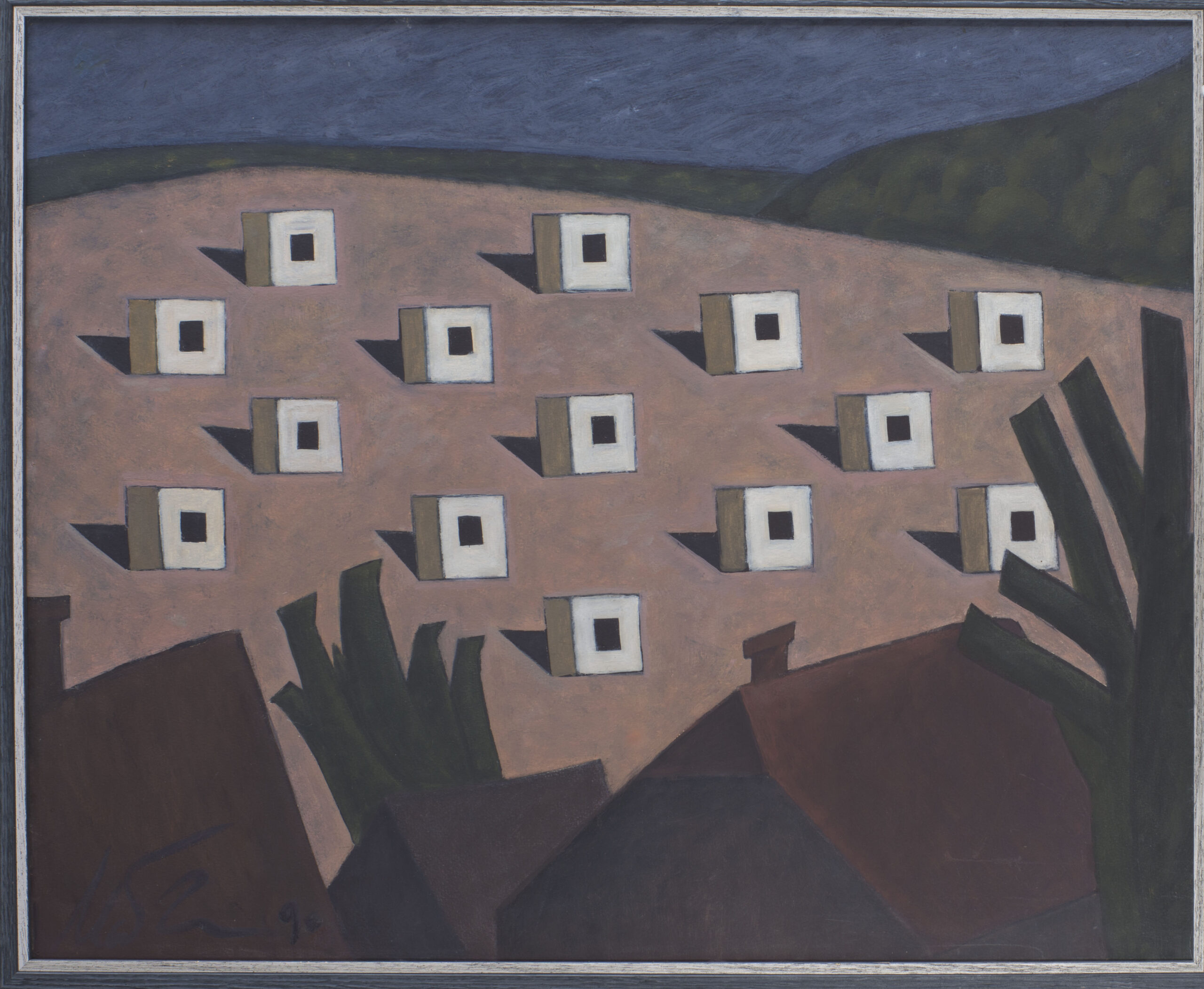 Figure 3. Return. Maryino I. (1990) by Mamut Churlu (oil on cardboard; 68.5×83.5cm).
Figure 3. Return. Maryino I. (1990) by Mamut Churlu (oil on cardboard; 68.5×83.5cm).
Crimean Tatar land reclamation in the wake of 1944 was a long process, traceable to the immediate aftermath of the deportation. Idris Asanin’s September 1944 poem “My Pledge,” the first poem about the deportation which the poet wrote in exile in Uzbekistan, asks, “Should the poor nation unjustly die and perish here? Should the plunders who have raided the homeland enjoy seeing this?” and then concludes thus:
My heart boils over with hatred.
Tears are flowing from my eyes.
Only one purpose, the path of struggle strengthens my will:
I pledge to follow in the footsteps of those who have pledged.
To sacrifice my soul for the rights of my people.[29]
Asanin was arrested in 1951 and sentenced to 25 years in prison; however, his resistance was not isolated. In the early-to-mid-1950s, young people distributed leaflets which called for the return of the Crimean Tatars to Crimea. Although these actions did not reach immediate success, they contributed to the long-term Crimean Tatar land-reclamation movement. This movement, which lasted 45 years, achieved Crimean Tatar return to the homeland in 1989. Upon return, the Crimean Tatars encountered the environmental consequences of Russian occupation: eroded soil, destroyed vineyards and tobacco fields, and contaminated water. A first and foremost land reclamation practice they developed in response was samozkhvaty (self-returns). This practice involved Crimean Tatars building their own houses. The 1989 painting by Crimean Tatar artist Mamut Churlu shows one of the “self-returned” Crimean Tatar villages (figure 3). In an interview, Churlu explained the absence of linear perspective in his paintings as a “method of stopping time.”[30] Time stopped in a picture frame reveals Crimean Tatar land reclamation as both a spatial and a temporal project. Crimean Tatars constructed the future by reclaiming the land—a future without the settler state.
[1] NTA TV Channel (2022) “Все так душевно, по-домашньому:” росіянка ридає, бо не хоче виїжджати з Криму [“Everything is so heartfelt, homely”: a Russian woman sobs because she does not want to leave Crimea]. YouTube, 10 August, https://www.youtube.com/watch?v=PAv9t94qimQ
[2] See https://www.instagram.com/p/CmthstTA8LF/
[3] See https://www.instagram.com/crimea_lovely/
[4] tzhu10 (2020) “Крым” (“Crimea”), Zemfira, 2020. Post-Soviet Dispatches, 19 May, https://postsovietdispatches.wordpress.com/2020/05/19/%D0%BA%D1%80%D1%8B%D0%BC-crimea-zemfira-2020/
[5] Alexandra Vagner (2020) “Это гибридная депортация”. Как изменился Крым за шесть лет после аннексии [“This is hybrid deportation”. How has Crimea changed in six years
since annexation?]. Svoboda, 4 March, https://www.svoboda.org/a/30489166.html
[6] Council of Europe and Commissioner for Human Rights (2023) Crimean Tatars’ struggle for human rights, 18 April, https://rm.coe.int/report-on-crimean-tatars-by-dunja-mijatovic-commissioner-for-human-rig/1680aaeb4b
[7] Hybrid Warfare Analytical Group (2021) How Russian Occupation Affects Ecology of Crimea. Ukraine Crisis Media Center, 1 November, https://uacrisis.org/en/how-russian-occupation-affects-ecology-of-crimea
[8] Konstantin Korovin (2023) Константин Коровин. Путешествия художника. В Крыму [Konstantin Korovin: Travels of the artist]. 10 May, http://kkorovin.ru/puti11.php
[9] Korovin compares Asan’s eyes to those of “an Arab horse” and his teeth to “peeled almonds”.
[10] Brenna Bhandar (2018) Colonial Lives of Property: Law, Land, and Racial Regimes of Ownership. Durham, NC: Duke University Press.
[11] Valeriy Vozgrin (1994) Імперія і Крим — довгий шлях до геноциду [Empire and Crimea: A Long Way towards Genocide]. Bakhchisaray, p.16
[12] Alan W. Fisher (1978) The Crimean Tatars. Stanford, CA: Hoover Institution Press, p.10
[13] Rory Finnin (2022) Blood of Others: Stalin’s Crimean Atrocity and the Poetics of Solidarity. Toronto: University of Toronto Press, p.17.
[14] Typography (2021) Solidarity, history, resistance: 6 stories about Crimean Tatars. Youtube, 18 May, https://www.youtube.com/watch?v=bosOYK_eI08
[15] Vozgrin (1994) Імперія і Крим, p.17.
[16] Edward Lazzerini (2019) “Claiming Crimea: A history of Catherine the Great’s southern
empire by Kelly O’Neill,” Ab Imperio 1: 298–308, p.305.
[17] Andreas Schönle (2001) “Garden of the Empire: Catherine’s Appropriation of the Crimea.” Slavic Review 60(1): 1–23.
[18] Finnin (2022) Blood of Others, p.58.
[19] Diane Koenker (2013) Club Red: Vacation Travel and the Soviet Dream. Ithaca: Cornell University Press p.25. The authors thank Keto Gorgadze for the book recommendation.
[20] Koenker (2013) Club Red, p.37.
[21] “Покровская Нина” [“Pokrovskaya Nina”] (2022) Prozhito, 19 August, https://prozhito.org/note/320321
[22] “Зотова Людмила” [“Zotova Lyudmila”] (2019) Prozhito, 23 September, https://prozhito.org/note/710626
[23] “Зотова Людмила” [“Zotova Lyudmila”] (2019) Prozhito, 23 September, https://prozhito.org/note/710675
[24] “Зотова Людмила” [“Zotova Lyudmila”] (2019) Prozhito, 23 September, https://prozhito.org/note/710677
[25] Mark Rifkin (2014) Settler Common Sense: Queerness and Everyday Colonialism in the American Renaissance. Minneapolis: University of Minnesota Press.
[26] Typography (2021) Solidarity, history, resistance.
[27] Dmitry Sokolov (2018) Коллективизация и раскулачивание в Крыму: как это было [Collectivization and dispossession in Crimea: How it happened]. Krymskoe Echo, 17 December, https://c-eho.info/kollektivizatsiya-i-raskulachivanie-v-krymu-kak-eto-bylo/
[28] Anne Spice (2018) Fighting Invasive Infrastructures. Environment and Society 9(1): 40–56.
[29] Finnin (2022) Blood of Others.
[30] Ekaterina Yakovenko (2020) МАМУТ ЧУРЛУ: «ШЕЛ 1989-Й ГОД. Я УСЛЫШАЛ ЗВУКИ КРЫМСКОТАТАРСКОЙ МЕЛОДИИ И ПОНЯЛ, НУЖНО ЕХАТЬ В КРЫМ» [MAMUT CHURLU: “IT WAS 1989. I HEARD THE SOUNDS OF THE CRIMEAN TATAR MELODY AND REALIZED THAT I NEEDED TO GO TO THE CRIMEA”]. Support Your Art, 5 August, https://supportyourart.com/conversations/mamut-churlu1/
Sasha Shestakova is a decolonial researcher. Their work deals with russian settler colonial histories and presents, combining visual culture and critical infrastructure studies. Their work has been featured at transmediale festival, Venice Biennale Architettura, Parse Journal, the European Review and nGBK Berlin.
Cite as
Sasha Shestakova and Anna Engelhardt. “Solidified Settler Perception,” JVC Magazine, 18 May 2023, https://www.journalofvisualculture.org/extractivism-6/
